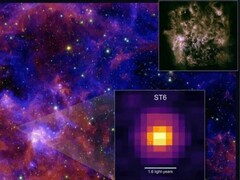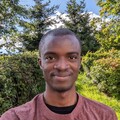 JWST discovers lifes building blocks in a distant galaxy (Image source: NASA)
JWST discovers lifes building blocks in a distant galaxy (Image source: NASA)
The James Webb Space Telescope has detected organic molecules, the precursors to life, around a newborn star 163,000 light-years away. The finding marks the first time these frozen compounds have been seen outside the Milky Way.
JWST detects frozen organic molecules beyond the Milky Way
A recent finding in outer space has left astronomers stunned. NASA’s James Webb Space Telescope (JWST) has spotted frozen organic molecules in the least place they were expected to be: around a young star located in a distant galaxy.
The scientists were studying ST6, a protostar (a star in its earliest stage of formation), when they discovered the carbon-based compounds. The ‘juvenile’ star inhabits the Large Magellanic Cloud (LMC), a dwarf galaxy found 163,000 light-years from Earth.
The research was led by Marta Sewilo of the University of Maryland. Using the JWST’s Mid-Infrared Instrument (MIRI), the team discovered the complex organic molecules (COMs or carbon-bearing molecules with more than six atoms) inside interstellar ice. They were near the Tarantula Nebula, one of the most prolific star production factories known to us.
A cosmic milestone for astrochemistry
The spotting of COMs is a major breakthrough for the JWST. It is the first time the extra-terrestrial telescope has discovered the raw ingredients of life outside the Milky Way, as previous discoveries were limited to our galaxy.
The carbon-bearing compounds offer an opportunity to broaden our understanding of the chemical complexities of regions where stars form. Scientists can also study the evolution of molecular chemistry under different galactic conditions. In fact, early analysis has suggested the presence of glycolaldehyde, which is a potential precursor to ribose, a sugar critical for RNA.
 David Odejide – Tech Writer – 333 articles published on Notebookcheck since 2024
David Odejide – Tech Writer – 333 articles published on Notebookcheck since 2024
I am a writer and software developer with a background in Mechanical Engineering and a distinction MSc in Environmental Management (Energy). My career spans fullstack development (building desktop, web, and Android apps for enterprise clients), Content Strategist/Business Developer in the solar industry, and writing research-driven articles on electric vehicles, renewable energy, and consumer tech.
I previously ran WindowsFoneFans (remember when Windows phones were a thing?) as a social media hub for Windows phone enthusiasts. My work includes hundreds of video scripts on EVs and sustainability, with over 100 million views on YouTube. I also write about chipsets, mobile hardware, and emerging IT trends, drawing on years of hands-on development experience.
Whether it is decoding Snapdragon nodes or analyzing offshore wind policy, I aim to deliver content that is both technically sound and widely accessible. In my spare time, I manage one of the largest LinkedIn groups for wind energy professionals and enjoy getting lost in Scotland’s natural beauty.

